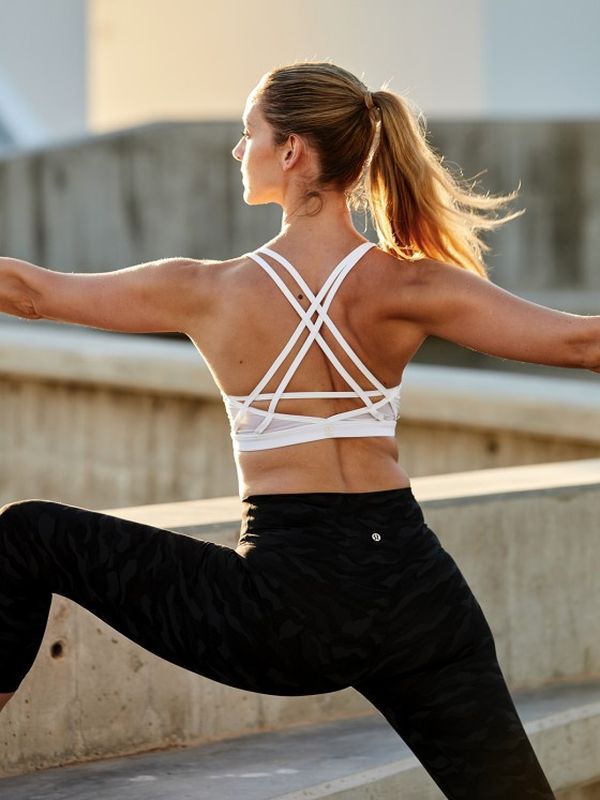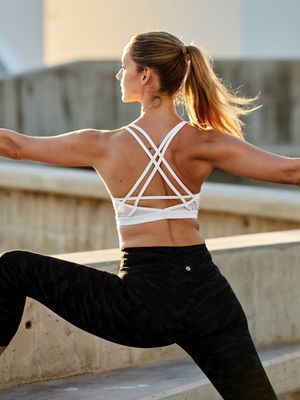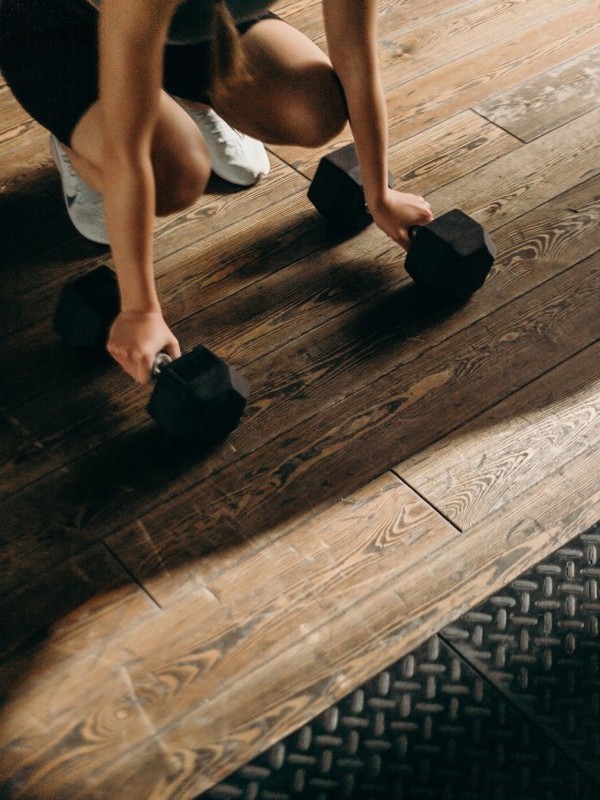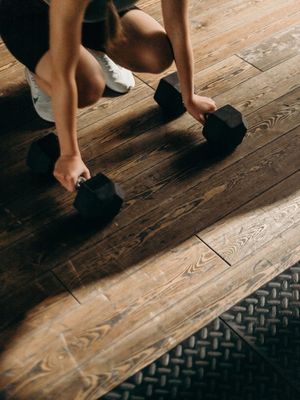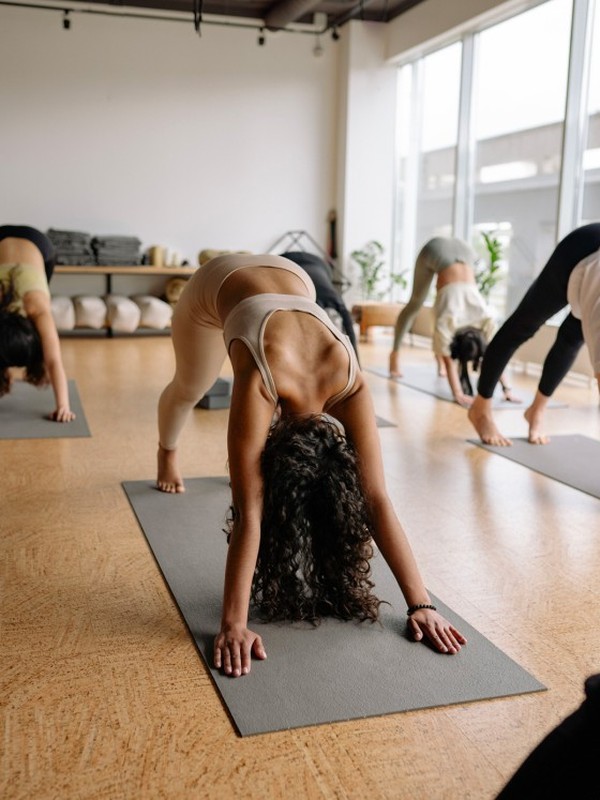
The 10 Rules Of Strength Training, According To Kayla Itsines
Reap The 360° Benefits
“Whether you’re a beginner or an elite athlete, strength training has so many benefits and is suitable for everyone of all fitness levels. Including strength training into your routine will improve your balance, core stability and strength, as well as your overall fitness and can also help build lean muscle. Weight training is also increasingly important as you age – it increases muscle strength and helps protect your joints from injury. It will also improve posture and increase bone density and strength.”
Drop The Weights
“Training with your bodyweight and weights are both effective – it just comes down to your preferred style of training and what suits your lifestyle. Some people think it’s better to use weights, but this isn’t necessarily the case – I’ve had so many women tell me they think they can’t get in a high-intensity workout without them and that’s just not true. Working with your bodyweight allows you to transition between exercises quickly and perform movements faster, and it some cases it can increase your heart rate even more than a weights-based session.”
Supercharge Your Moves
“There are some moves people always do incorrectly. When doing a squat, keep your knees in line with your toes, keeping your feet shoulder-width apart and your knees straight – you don’t want them to fall or point inwards. When holding a plank, brace your core and maintain a neutral spine, pressing away from the ground; don’t let your hips drop and focus on pulling your feet and elbows towards each other. Finally, when it comes to push-ups, keep your wrists in line with your shoulders, brace your core and keep a neutral spine, twisting your hands into the floor to stabilise your shoulders; your elbows should point towards your feet while bending, not out to the side.”
Take A Long-Term Approach
“You should focus on how your training makes you feel, not just the physical results. When starting a new programme, it’s important to have a long-term focus instead of looking for a quick fix. After your first week of strength training, you should start to notice an increase in your energy levels, improvement in your sleep and mood. After just a few weeks, you’ll feel more confident in your workouts and certain exercises will start to feel easier. Within just a few months of training consistently, you’ll start to see physical changes in your muscle definition and continue to notice progress in your overall strength and stamina.”
Ignore Your Heart Rate
“There’s no need to obsess over your heart rate when weight training – the key lies in paying attention to how your body feels. If you’re feeling good and strong, try to push yourself that little bit further, but if you’re feeling sluggish, take your time, go at your own pace and remember doing something is always better than doing nothing.”
Prioritise Recovery
“Everyone is guilty of skipping recovery sessions, but they are vital to assist muscle recovery and reduce soreness. The aim is to kickstart recovery as soon as you can after your workout – always take a few minutes to post-session to stretch your muscles and lower your heart rate. Foam rolling is also a powerful tool to support muscle recovery and improve range of motion. You should always stretch out your hip flexors, glutes and front of your shoulders before and after a workout. The best thing you can do to ease DOMS (delayed onset muscle soreness) is to avoid overtraining, especially if you are just starting out. Remember consistency is key when it comes to training, and training consistently, not more, will help you progress steadily towards your goals.”
Think About Nutrition
“It’s crucial to fuel your body with nutrient-rich foods after a workout to replenish energy levels and support recovery. It doesn’t always have to be a full meal – any combination of protein and carbs from whole foods is perfect. When it comes to nutrition, keep it simple; healthy eating shouldn’t be complicated. Forget measuring your food, instead eating a nutrient-rich diet that includes a variety of fruits and vegetables, protein to build and repair muscles, and healthy fats from avocados, nuts and olive oil. After a workout, try a banana with a small handful of nuts; some Greek yoghurt with berries; or apple slices with nut butter.”
Know When To Level Up
“When it comes to strength training, it’s important to know when to increase the intensity to continue to see results. If you ever reach a point where you feel like you’re cruising through your workouts or your sessions are feeling easy, this could be a sign it’s time to level up. You could start by increasing the weights you are using – for example, switching from 5kg dumbbells during walking lunges to 7kg. Also consider pushing yourself by choosing a challenging progression of an exercise, like progressing from a squat to a jump squat, or instead of a regular burpee, try a chest-to-floor burpee. You could also simply increase the number of repetitions you do for each exercise, upping the number of laps or sets in a circuit or performing more reps within each set. Challenge yourself and see how quickly you can get through a workout – the faster you get through, the fitter you are getting.”
Create Structure
“Try to incorporate three strength training sessions each week, with a session each dedicated to your legs, arms and abs, and full body. Consider doing these on, say, a Monday, Wednesday and Friday to allow enough time for your body to recover between sessions. If you’re new to strength training, or getting back into it after time off, focus solely on full-body sessions to build foundational strength. Once you have been working out consistently for a few weeks, increase the intensity of your workouts by splitting them per body focus. Remember you shouldn’t just focus on strength training, even if building strength is your goal – try to include two to three LISS (low-intensity steady state cardio) sessions each week. When doing these lower-intensity sessions, keep to a low-to-moderate intensity for a continuous period of time; this could be a 30-minute walk, swimming or cycling.”
Forget The Numbers
“Always focus on technique rather than the weight you are lifting. Form and technique are so important to ensure you’re targeting the right muscles. Start light and as you build confidence and your technique improves, look to increase the amount of weight you are lifting. For the majority of exercises, it’s vital to set your shoulders back and down, embrace your core and engage your glutes. Doing this means you’re moving with a strong base of support through each exercise. My BBG programmes in the SWEAT app have written instructions for each exercise as well as pointers and visuals for optimum technique. Try filming yourself doing an exercise and watch it back while referencing the videos to see if your technique matches – this is a great way to see where you could improve.”
Visit SWEAT.com for more information or download the app here. Follow Kayla on Instagram @Kayla_Itsines.
*DISCLAIMER: Features published by SheerLuxe are not intended to treat, diagnose, cure or prevent any disease. Always seek the advice of your GP or another qualified healthcare provider for any questions you have regarding a medical condition, and before undertaking any diet, exercise or other health-related programme.
DISCLAIMER: We endeavour to always credit the correct original source of every image we use. If you think a credit may be incorrect, please contact us at info@sheerluxe.com.


